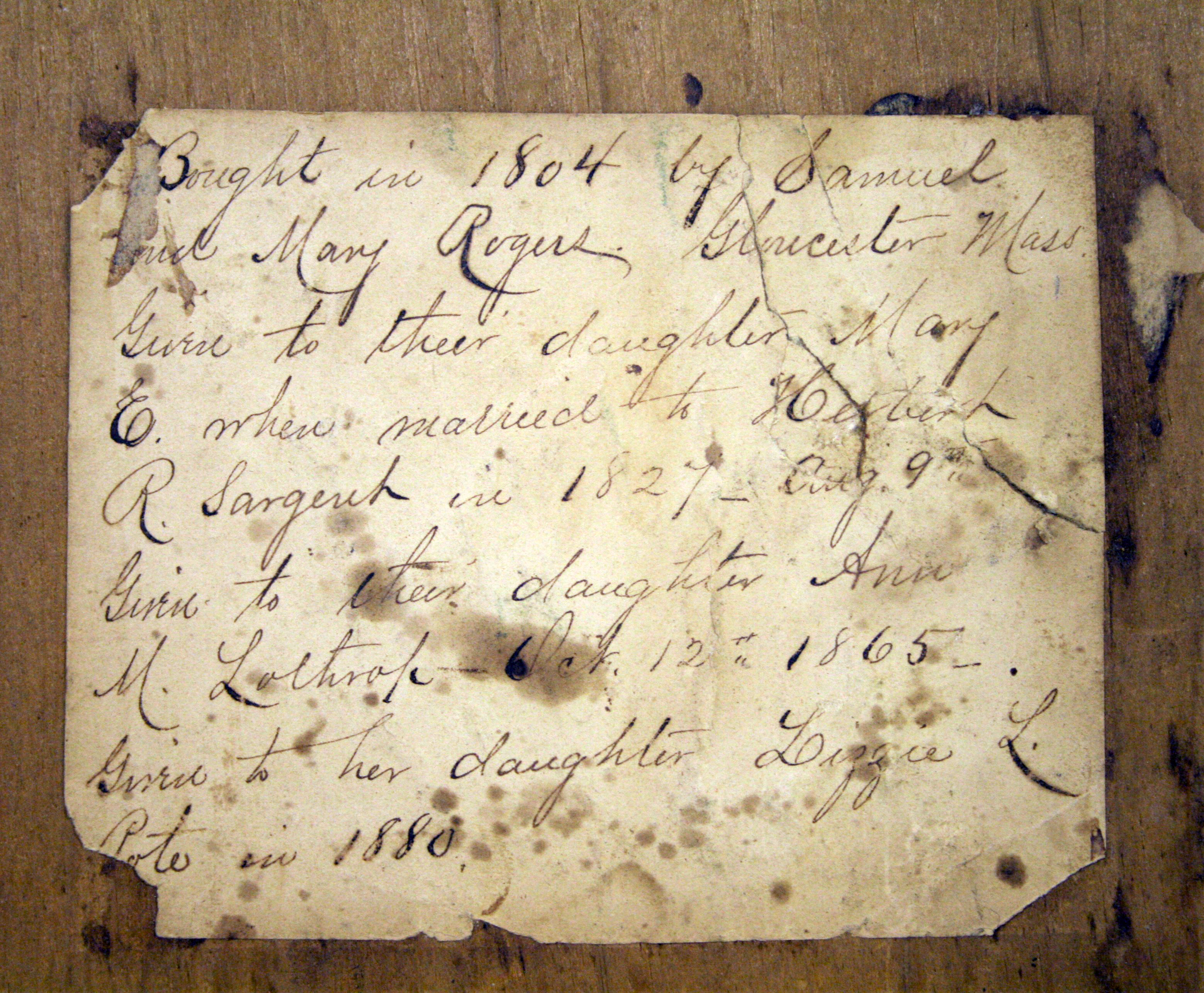Hepplewhite Sideboard
A Legacy Passed Down from Mother to Daughter
.jpg)
Unattributed, Hepplewhite Sideboard, c. 1804. Mahogany and brass with inlay. Collection of the Cape Ann Museum, Gloucester, MA. Gift of Roswitha and William Trayes, 2012 [Acc. #2012.38.1].
This Hepplewhite sideboard currently on view in the Fitz Henry Lane Gallery was made on the North Shore and originally owned by Samuel and Lucy (Foster) Rogers of Gloucester; it was acquired by them at the time of their marriage in 1804. The sideboard as a piece of household furniture can be traced back to the Middle Ages and is related to the use of a side table (or “board”) in a homeowner’s dining area for storing and displaying eating utensils and for serving food. The English architect Robert Adam (1728–1792) is commonly credited with the development of the sideboard’s customary composition of three sections, consisting of an oblong surface with two supporting end cupboards and a center drawer.
As with many household accoutrements, over time the sideboard became a reflection of the social status of the homeowner, its presence indicating a dwelling large enough to dedicate a room solely to the purpose of eating. By the 19th century, a sideboard was a highly desirable piece of furniture, and a woman who brought one into her home would be contributing significantly to the prosperity of the union. Perhaps it is for this reason that the ownership of this particular sideboard in the Museum’s collection has been traced through the women whose houses it graced. Adhered inside one of the drawers, a slip of paper records the passage of this piece from mother to daughter through four generations.

A slip of paper found inside the sideboard detailing passage of the c.1804 sideboard from mother to daughter through four generations.
Samuel Rogers and Lucy Foster were married in Gloucester in 1804, and they probably purchased this sideboard at that time to furnish their new home. Where the “Mary” on the label comes from is not clear; it could be simply that the person who wrote the label many years later misremembered her name. After being used for two decades, in 1827 the sideboard was given to their daughter, Mary Elizabeth Hough Rogers (1805–1896) upon her marriage to Herbert Redding Sargent, also of Gloucester.
After they were married, Mary and Herbert moved to Belfast, Maine, where their eldest daughter Ann Morrill Sargent (1829–1864) was born. Mary passed the piece on to her daughter after Ann wed Captain Sumner P. Lathrop in Belfast; Ann in turn transferred it to her daughter Lizzie (1851–1911) during her marriage to Frederick Pote. Lizzie and Fred Pote never had any children, and the trail of the sideboard’s ownership remained a mystery until 2012, at which time it was put up for auction and purchased for the Cape Ann Museum by Roswitha and William Trayes of Rockport.
Several features of this sideboard identify it as an example of the Hepplewhite style that first became popular in 18th century England and was subsequently copied by American furniture makers. The straight, tapered legs that end in a simple pointed foot as well as the inlaid decorative detail are characteristic of Hepplewhite’s designs as is the bow front. Overall, the piece is lighter with a more delicate and rectilinear form than earlier Queen Anne pieces, and it lacks the intricate carving and curvilinear elements that distinguish the Chippendale style. George Hepplewhite (c.1727-1786) was a London-based furniture maker whose purported designs were published posthumously by his wife Anne under the name A. Hepplewhite & Co. in The Cabinet Maker and Upholsterer’s Guide of 1788, a resource that is known to have been present in several American furniture workshops in the 18th and 19th centuries.
Find more examples of Hepplewhite furniture in the Museum's collection here.
![Hepplewhite Looking Glass. American, c. 1790. Wood, plaster, wire and guild. Collection of the Cape Ann Museum, Bequest of E. Hyde Cox, 1998 [Acc. #1998.36].](/media/pieces/IMG_0009b.jpg)
![Hepplewhite Sideboard. c. 1790. Mahogany with inlay. Collection of the Cape Ann Museum, Bequest of E. Hyde Cox, 1998 [Acc. #1998.36.22].](/media/pieces/IMG_0015a.jpg)
![Hepplewhite tall clock. Boston, c. 1805. Mahogany and veneer with inlay. Collection of the Cape Ann Museum, Bequest of E. Hyde Cox, 1998 [Acc. #1998.36].](/media/pieces/IMG_0013b.jpg)
(left to right) Hepplewhite Looking Glass. American, c. 1790. Wood, plaster, wire and guild. Collection of the Cape Ann Museum, Bequest of E. Hyde Cox, 1998 [Acc. #1998.36]; Hepplewhite Sideboard. c. 1790. Mahogany with inlay. Collection of the Cape Ann Museum, Bequest of E. Hyde Cox, 1998 [Acc. #1998.36.22]; Hepplewhite tall clock. Boston, c. 1805. Mahogany and veneer with inlay. Collection of the Cape Ann Museum, Bequest of E. Hyde Cox, 1998 [Acc. #1998.36].